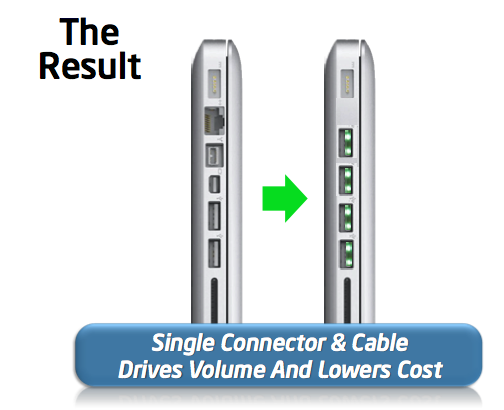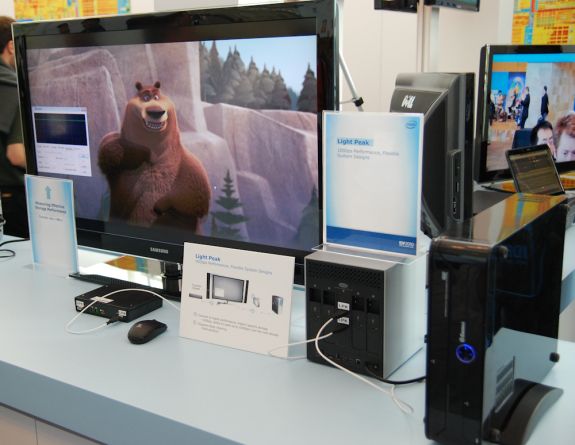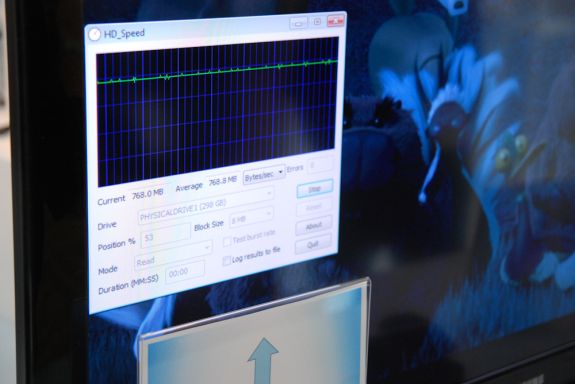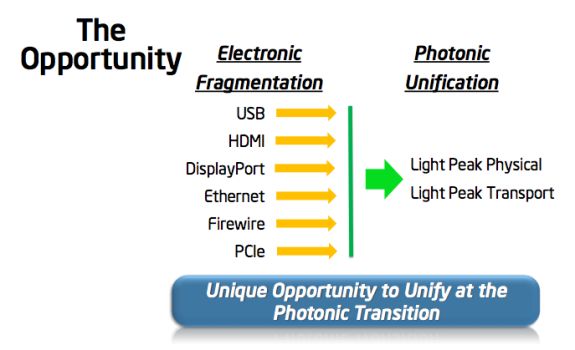Intel Light Peak - Lighting up 10 Gbps links in 2011
by Brian Klug on September 16, 2010 3:40 PM EST- Posted in
- Trade Shows
- Intel
- LightPeak
The second demo involved a desktop PC with Light Peak connecting to a modified LaCie 4big Quadra, daisy chained to another display with a built in HDMI adapter. Note that Light Peak supports daisy chaining as this demo was connected, but also supports a star topology like USB does.
At the far left on the TV was the total bitrate of the storage system, which showed a solid 768.8 megabytes/s of throughput. That's 6.15 gigabits per second of throughput. Obviously the video must have been uncompressed to achieve such high bitrate, but the display itself was only 1080P.
Both of these demos really show how close Intel is to finalizing Light Peak for consumer consumption, and how closely they've been working with partners like Western Digital and Avid for having devices ready eventually.
Obviously USB will live on for years, and USB 3.0 still isn't completely ubiquitous, but the allure of using a single connection and cable for everything sometime in the future is hard to pass up.
The Tech
I spoke with Jason Ziller - Intel's director of Optical I/O planning - about what's left for Light Peak before we can all start enjoying one superfast desktop connection. Availability was originally slated to be Q4 2010, that date has now slipped to sometime inside 2011.

Remember that USB-like port? It actually is USB, but that's only for ease of testing until Light Peak's new connector is finalized. The connector won't look like USB, and obviously will have something unique to mitigate both alignment and potential damage to the interface. Intel isn't ready to say what this looks like, but obviously the connector will be subject to the same kind of scrutiny that USB was for durability and consumer friendliness.
Light Peak isn't a protocol, but instead simply provides a new physical layer for existing connector protocols. Traffic like DVI-D, HDMI, USB, and audio can all coexist across Light Peak.
Intel didn't need to use WDM (Wavelength Division Multiplexing) to achieve 10 Gbps as demonstrated, and maintains that although WDM could be used in the future to increase bandwidth, there are other ways to scale to 100 Gbps. Currently Light Peak is 100 meters capable, though the actual product will be 50 meters of distance. Cables have sufficiently small bend radius that they can be wrapped in a knot or around a pencil without the connection losing connectivity, and up to 7 devices can be daisy chained.
Interestingly, Intel is using an 850 nm wavelength laser for the system, and (unsurprisingly) multimode fiber. Data is bidirectional across the interface as well. 850 nm is a rather interesting choice, as it's still subject to class 1 eye safety limits (just above -4 dBm), but moreso because it was the wavelength used in some of the world's very first long haul fiber optic networks.
Intel's silicon photonics remain a separate project from Light Peak, as Light Peak uses VCSEL laser diodes. The long term vision is to eventually bring the two together in a much broader scope to bridge datacenters together instead of just desktops.
There's a lot of potential for the future of desktop optical interfaces - Intel just has to deliver them. Let's hope it happens in 2011 as promised!













59 Comments
View All Comments
gft74 - Thursday, September 16, 2010 - link
The article mentions that lightpeak is simply a transport. Does anyone know the feasibility of implementing say SCSI, or Firewire protocols on top of it?-gft
vol7ron - Thursday, September 16, 2010 - link
that shouldn't be hard, but really why would you want to?the real aim should be that external devices begin to have a light port.
Brian Klug - Thursday, September 16, 2010 - link
Because it's simply a physical layer transport, anything should work over it. SCSI, Firewire, you name it. I believe some of the only problems are making sure those protocols work at the respective speeds, but the physical Light Peak layer does allow bitrates that high.That's directly from intel, hopefully it doesn't change. They state they have no intentions of changing anything like USB, but rather using USB over Light Peak.
-Brian
cdillon - Thursday, September 16, 2010 - link
SCSI as a protocol (not the interface) is already used EVERYWHERE for mass-storage applications. Firewire, USB, FibreChannel, and SAS all use the SCSI command-set for mass-storage. I think by extension we can assume that Light Peak already speaks SCSI to some extent since it is meant to be, at the very least, a USB replacement.Did you know all modern CD/DVD drives actually speak SCSI? ATAPI == ATA Packet Interface, which transports SCSI commands over [S|P]ATA. This was a boon for both the CD/DVD drive manufacturers and software creators which had been using SCSI drives for years and years. With ATAPI, only the physical interface changed, not how you talked to the drives.
ATA, as a storage protocol, is really the "odd man out".
solipsism - Thursday, September 16, 2010 - link
Is the adapter receiving power from a cooper power wire from LightPeak source?holywarrior007 - Thursday, September 16, 2010 - link
It is bit disappointing that Intel keeps postponing these dates. First SB was going to arrive in Q42010 but now it will arrive in early 2011. Light peak was also going to arrive in Q42010 but it will come one year later. Intel has been, for whole this year, aggressively suggesting that it will come this year. Looks like folks at Intel can't keep any promise. A little competition to Intel is needed here badly.melgross - Thursday, September 16, 2010 - link
Intel has just said that we won't see any products until 2012 because the chipset won't be ready until late 2011.holywarrior007 - Thursday, September 16, 2010 - link
I know I read it somewhere too. But Intel has been saying for sometime that chipset would be available by Q42010 and products will after that. Now it will take one more year, which sucks. But this is not something new, Intel has recently delayed lots of deadlines. I wish if AMD has started offering USB 3.0 chipset then Intel would have hurried up with the Lightpeak.vol7ron - Thursday, September 16, 2010 - link
I rather see delays then products with complications.probedb - Friday, September 17, 2010 - link
Well they can either delay it and get it right or rush it out to make you happy and it could be full of bugs.I know which I'd prefer.